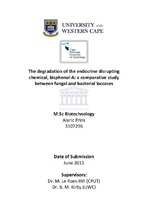| dc.description.abstract | The degradation of endocrine disrupting chemicals (EDCs) is a topic of high importance and one that research efforts are continually being focused on. These harmful chemicals are known to cause adverse health effects in humans and animals. In particular, bisphenol-A (BPA), a high volume chemical which is mainly used in the manufacturing of polycarbonate plastics and epoxy resins have been shown to be implicated in the development of a variety of health problems. In this study, the ability of two fungal laccases [Trametes versicolor (TvL) and Trametes pubescens (TpL)], and two bacterial laccases [Streptomyces coelicolor (SLAC), and a mutant of SLAC (SLAC- VN)] to degrade or remove BPA from solution was investigated. The commercial preparation of TvL was used for the purposes of this study, while TpL was produced from the native strain. T. pubescens was cultured in shake-flasks, the supernatant harvested and subjected to ammonium sulphate precipitation. SLAC and SLAC-VN were produced from recombinant strains using a standard protocol and the enzymes purified by size-exclusion chromatography. The presence of the laccases were confirmed by the 2,6-dimethoxyphenol assay and sodium dodecyl sulphate polyacrylamide gel electrophoresis (SDS-PAGE).The removal or degradation of BPA from solution was determined for the free enzymes, as well as the enzymes in immobilised form. For immobilisation, the enzymes were encapsulated in sodium alginate beads and cross-linked to form cross- linked enzyme aggregates (CLEAs).High levels of BPA removal was exhibited by the fungal laccase, TpL (100% removal)and the bacterial mutant laccase, SLAC-VN (96%) in their free form. When all four laccases were encapsulated in sodium alginate beads, a number of changes to the characteristics of the enzymes were observed. Overall, the level of BPA removal was reduced for all enzymes as when compared to the free laccases, while SLAC-VN removed more BPA than either of the fungal laccases (59% for SLAC-VN versus 57% TvL and 54% for TpL). The encapsulation of the laccases in alginate beads also led to changes in the optimal temperature for BPA removal, with all encapsulated laccase being able to remove BPA optimally at 40°C. The immobilisation of the laccases in CLEA form had the most significant effect on the BPA removal ability of the laccases. The pH range for both fungal laccases was extended beyond the acidic range [for TpL, optimal removal occurred at pH 8.5 compared to pH 4.5 (free) and pH 6.0 (encapsulated)]. Most remarkable, however, was that the formation of CLEAs greatly enhanced the BPA removal ability of SLAC (60% removal compared to 25% when encapsulated). | en_US |

